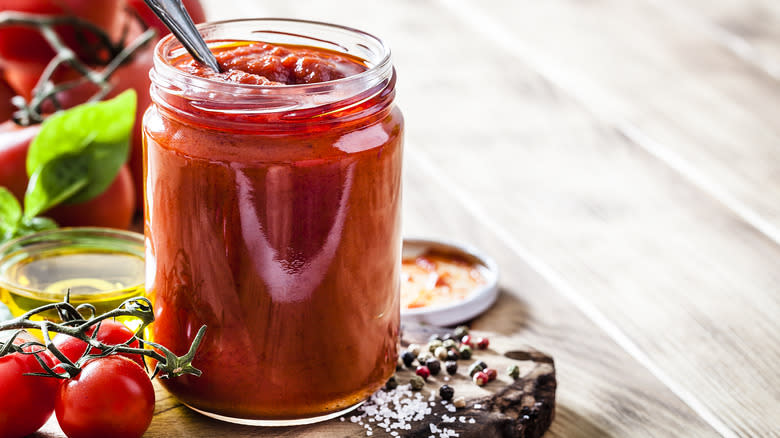Swish Some Wine In Your Almost-Empty Tomato Sauce Jars To Use Up Every Bit

Waste not, want not goes the motto of the ethically frugal. It's a noble -- if, at times, sadly impractical -- way to live given our disposable culture. Few places, though, is that more important to keep in mind than in the kitchen, where shameful amounts of perfectly good food gets pitched just for the ease of it. Consider jarred foods, where remnants that cling to the inside are often tossed out along with the container.
Though it may seem insignificant, depending on the size of the vessel, there may be more left behind than there seems to be. And, given that you've likely paid for the food inside, you should get your money's worth. There's no single method for getting the most out of every jarred food, though some are easier to salvage than others. Take, for instance, jarred tomato sauce. It's a product that can really simplify weeknight dinner preparation but often results in considerable amounts of tasty dregs left behind in the container.
That's flavor that should be coating pasta or aiding in the braising of meat. And that's where wine comes in. The method is pretty straightforward: Add wine to the almost-empty tomato sauce jar, give it a shake to loosen everything up, and add it to your sauce. Of course, this can be accomplished with stock or even water, but wine adds a complementary note to tomatoes -- and the alcohol helps accentuate certain flavor compounds -- so we almost always reach for a wine bottle to get the most out of our sauce jars.
Read more: 26 Types Of Pasta Sauce Explained
Consider The Quantity And Style Of Wine You Use

The idea may be simple, but there are definitely some variables that you want to consider before willy-nilly rinsing tomato sauce jars with wine and dumping the lot in with a simmering sauce. First, think about how much wine is needed. A small amount will definitely free the remaining sauce, but is that enough -- or too much -- for the volume of your finished dish? Second, don't feel like you have to add the wine-tomato sauce slurry directly to the pot.
Adding wine early means it has time to reduce and soften as it cooks. Tossing it in toward the end, though, leads to punchier, brighter flavors and even a bit of unevaporated alcohol in the final product. Neither is wrong, it just depends on what you want to achieve. Thought should also be given to what kind of wine you are using. Let's say the majority of your tomato sauce goes into a braise with rich beef short ribs and hearty herbs, like rosemary.
Reach for a wine with backbone, like a classic Burgundy or an American pinot noir, that deepens the braising liquid and offers balance to the savory meat. On the other hand, you may be on your way to a bright tomato sauce, such as a classic amatriciana, which calls for white wine. A dry Italian pinot grigio or ebullient soave adds zippy fruit flavors without a bit of sweetness, underlining the tang of the tomatoes and countering umami elements.
Read the original article on Tasting Table.


